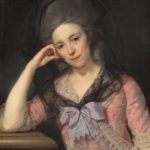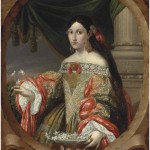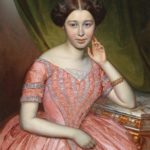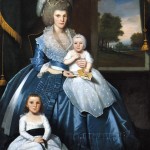Maria Anna Mozart as a child by Pietro Antonio Lorenzoni, 1763
Maria Anna Walburga Ignatia Mozart (30 July 1751 – 29 October 1829), called Marianne and nicknamed “Nannerl”, was a musician, the older sister of Wolfgang Amadeus Mozart and daughter of Leopold and Anna Maria Mozart.
Maria Anna (Marianne) Mozart was born in Salzburg. When she was seven years old, her father Leopold Mozart started teaching her to play the harpsichord. Leopold took her and Wolfgang on tours of many cities, such as Vienna and Paris, to showcase their talents. In the early days, she sometimes received top billing, and she was noted as an excellent harpsichord player and fortepianist.
However, given the views of her parents, prevalent in her society at the time, it became impossible as she grew older for her to continue her career any further. According to New Grove, “from 1769 onwards she was no longer permitted to show her artistic talent on travels with her brother, as she had reached a marriageable age.” Wolfgang went on during the 1770s to many artistic triumphs while traveling in Italy with Leopold, but Marianne had to stay home in Salzburg with her mother. She likewise stayed home with Leopold when Wolfgang visited Paris and other cities (1777–1779) accompanied by his mother.
There is evidence that Marianne wrote musical compositions, as there are letters from Wolfgang praising her work, but the voluminous correspondence of her father never mentions any of her compositions, and none have survived.
In contrast to her brother, who quarreled with their father and eventually disobeyed his wishes with respect to career path and choice of spouse, Marianne remained entirely subordinate to her father. She fell in love with Franz d’Ippold, who was a captain and private tutor, but was forced by her father to turn down his marriage proposal. Wolfgang attempted, in vain, to get Marianne to stand up for her own preference.
Eventually, Marianne married a magistrate, Johann Baptist Franz von Berchtold zu Sonnenburg (23 August 1783), and settled with him in St. Gilgen, a village in Austria about 29 km east of the Mozart family home in Salzburg. Berchtold was twice a widower and had five children from his two previous marriages, whom Marianne helped raise. She also bore three children of her own: Leopold Alois Pantaleon (1785–1840), Jeanette (1789–1805) and Maria Babette (1790–1791).
An unusual episode in Marianne’s life occurred when she gave birth (27 July 1785) to her first child, a son who was named Leopold after his grandfather. Marianne had traveled from her home in St. Gilgen to Salzburg for the birth. When she returned to St. Gilgen, she left her infant in the care of her father and his servants. The elder Leopold stated (by a letter that preceded Marianne back to St. Gilgen) that he would prefer to raise the child for the first few months himself. In 1786, he extended the arrangement to an indefinite term. Leopold continued to care for his grandson, taking delight in his progress (toilet training, speech, and so on), and commencing with the very beginnings of musical training. Marianne saw her son on occasional visits, but in general was not involved in his care. The arrangement continued until the death of her father, on 28 May 1787.
Biographers differ on what was the basis for this arrangement. Little Leopold was ill in his infancy, and perhaps needed to be kept in Salzburg for this reason, but this does not explain why he was still kept there after his recovery. Another possibility attributes the arrangement to Marianne’s delicate health or her need to take care of her stepchildren. Biographer Maynard Solomon attributes the arrangement to Leopold’s wish to revive his skills in training a musical genius, as he had done with Wolfgang. He also suggests that giving up her son was indicative of Marianne’s total subordination to her father’s wishes.
Marianne’s husband died in 1801. She returned to Salzburg, accompanied by her two living children and four stepchildren, and worked as a music teacher. In her old age, Marianne had her first encounter in person with Mozart’s widow Constanze since the visit of 1783. In 1820, Constanze and her second husband Georg Nikolaus von Nissen moved to Salzburg. Although Marianne had not even known that Constanze was still alive, the encounter was apparently “cordial”, though not warm. Eventually, Marianne did the Nissens a great favor: To help them write a biography of Wolfgang, Marianne lent the Nissens her collection of family letters, including Wolfgang and Leopold’s correspondence up to 1781.
In 1821, Marianne enjoyed a visit from Wolfgang’s son, Franz Xaver Mozart, whom she had never met during her brother’s lifetime. The son had come from his home in Lemberg to conduct a performance of his father’s Requiem in remembrance of the recently deceased Nissen.
In her last years, Marianne’s health declined, and she became blind in 1825. Mary Novello, visiting in 1829, recorded her impression that Mrs. Berchtold was “blind, languid, exhausted, feeble and nearly speechless,” as well as lonely. She mistakenly took Marianne to be impoverished, though in fact she was frugal and had left a large fortune (7837 gulden).
Marianne died on 29 October 1829, at 78 years, and was buried in St Peter’s Cemetery, Salzburg.
Via: WikiCommons





